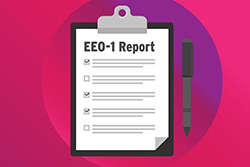Employer Solutions / HRMS Newsletter – September 2019
Keeping You Up-To-Date With Information About Employer Solutions / HRMS
Compliance Corner: EEO-1, Component 2 (Pay Data) due September 30
 As many readers may know, the Equal Employment Opportunity Commission (EEOC), following the U.S. District Court decision in National Women’s Law Center v. Office of Management and Budget (OMB) announced that covered employers must submit employees’ W-2 pay and hours worked data (which the EEOC has referred to as a Component 2 EEO-1) for years 2017 and 2018 by Sept. 30, 2019.
As many readers may know, the Equal Employment Opportunity Commission (EEOC), following the U.S. District Court decision in National Women’s Law Center v. Office of Management and Budget (OMB) announced that covered employers must submit employees’ W-2 pay and hours worked data (which the EEOC has referred to as a Component 2 EEO-1) for years 2017 and 2018 by Sept. 30, 2019.
The EEOC historically has collected information from covered employers regarding an employer’s number of employees by job category, race, ethnicity and sex (Component 1 data) using the EEO-1 report. The EEO-1 report (Standard Form 100) is collected annually under the authority of Title VII of the Civil Rights Act of 1964 (Title VII).
The filing of Standard Form 100 is required by law. All private employers employing 100 or more employees and subject to Title VII must submit an EEO-1 report annually. Most federal contractors and subcontractors that employ 50 or more employees also are required annually to submit an EEO-1 report (however, only those federal contractors that employ 100 or more employees are required to submit Component 2 data).
Recently, Net at Work presented two webinars on this topic that readers might be interested in. Click on the webinar title for a link to a recording of the session and copy of the slide deck. Additional consulting assistance is available by contacting your Net at Work Account Manager or helpdesk@netatwork.com and scheduling time with one of our consultants.
EEO-1 Reporting with Sage HRMS and Abra Suite
EEO-1, Component 2 (Pay Data): a Sage HRMS Product Walkthrough
New W-4 Coming for 2020
Form W-4 is completed by employees and given to their employer so their employer can withhold the correct federal income tax from the employee’s pay. According to the IRS, employees should consider completing a new Form W-4 each year and when their personal or financial situation changes. A revised draft W-4 form for 2020 was released in August.
The revised form implements changes made following the 2017 Tax Cuts and Jobs Act, which made major revisions affecting taxpayer withholding. The redesigned Form W-4 no longer uses the concept of withholding allowances, which was previously tied to the amount of the personal exemption. Due to changes in the law, personal exemptions are currently not a central feature of the tax code.
Open Enrollment Time: Are You Including Your ACA Defined Qualified Employees?
Many companies are gearing up for their annual benefit Open Enrollments. This is a good time for HR to review who should be offered health care benefits under the Affordable Care Act and take steps to make sure that eligible employees are included in their Open enrollment process.
In order to avoid potential penalties, it is important for applicable large employers, ALEs, to understand how to determine which employees are “full-time” under the ACA and should be eligible for benefits.
Full-Time Employee
A full-time employee is an individual reasonably expected to work at least 30 hours per week. For this purpose, “hours” include each hour for which an employee is paid or entitled to payment for performing duties for the employer or entitled to payment even if no work is done (e.g. holiday, vacation or sick time).
Variable Hour Employees
An employee may be eligible for benefits if they are a variable hour employee. The ACA defines an employee as variable hour if, based on the facts and circumstances on the employee’s start date, an employer cannot determine whether the employee is reasonably expected to work an average of at least 30 hours per week during the initial measurement period because the employee’s hours are variable or uncertain.
There are several factors to consider in evaluating whether it is reasonable to determine that a new employee is a variable-hour employee, including but not limited to:
- Whether the employee is replacing an employee who was or was not a full-time employee,
- The extent to which employees in the same or comparable positions are or are not full-time employees, and
- Whether the job was advertised, communicated to the new hire or otherwise documented (for example, through a contract or job description), as requiring hours of service that will average 30 or more hours of service per week or less than 30 hours of service per week.
Employers identify which variable hour employees should be treated as “full-time” and benefits eligible by:
Calculating average weekly hours worked during a look-back specified period of months (such as 6 or 12 months) which is referred to as a measurement period.
Locking in the employees’ status (“full-time” benefits eligible or benefits ineligible) during a subsequent specified period of months following the measurement period, which is the stability period.
The employee’s benefits eligibility status is based on the calculation from the measurement period and is locked in for the entire duration of the stability period, regardless of the number of hours the employee actually worked during the stability period. However, the actual hours worked will be counted as part of the next measurement period.
Review of the measurement periods for variable hour employees should be done as part of the preparation for open enrollment to determine if an employee continued to be eligible for benefits based on the measurement period. In other words, did the variable hour employee continue to work at least 30 hours per week during the measurement period? If not, they would no longer qualify for benefits under the ACA.



